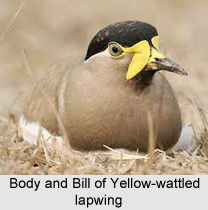 Yellow-Wattled Lapwing is an Indian Bird of migratory nature; that bears a scientific name "Vanellus malabaricus" is coming from the lapwing.
Yellow-Wattled Lapwing is an Indian Bird of migratory nature; that bears a scientific name "Vanellus malabaricus" is coming from the lapwing.
Concentration of Yellow-Wattled Lapwing
Yellow-Wattled Lapwing is endemic to the Indian Subcontinent. Yellow-Wattled Lapwing is found mainly on the dry plains of peninsular India and has a sharp call and is capable of fast flight. Although they do not migrate, they are known to make seasonal movements in response to rains. Yellow-Wattled Lapwing is common in much of India, being seen in a variety of open lowland habitats. It tends to be seen in drier habitats than the red-wattled lapwing, Vanellus indicus. They are found in most parts of India, parts of Pakistan, Nepal, Bangladesh and Sri Lanka.
Structure of Yellow-Wattled Lapwing
Yellow-Wattled Lapwings are dull grey brown with a black cap, yellow legs and a triangular wattle at the base of the beak. Like other lapwings and plovers, they are ground birds and their nest is a mere collection of tiny pebbles within which their well camouflaged eggs are laid. The chicks are nidifugous, leaving the nest shortly after hatching and following their parents to forage for food. There are no recognized subspecies, but there is a size increase from south to north. They are 260-280mm long with a wing of 192-211mm, bill 23-26mm, tarsus 57-66mm and tail 71-84mm.
Residence of Yellow-Wattled Lapwing
Yellow-Wattled Lapwings are conspicuous and unmistakable birds found in dry stony and open grassland or scrub habitats. They are medium-sized pale brown waders with a black crown which is separated from the brown on the neck by a narrow white band and large yellow facial wattles. The chin and throat are black and the brown neck and upper breast is separated from the white belly by a narrow blackish line. The tail has a sub terminal black band which does not extend into the outer tail-feathers. There is a white wing bar on the inner half of the wing. The bill is yellow at the base. They have tiny yellow carpal spurs. The crown feathers can be raised slightly in displays. They are mostly sedentary but populations make long distance movements in response to the monsoons. They are occasional visitors to the Katmandu valley in Nepal.
Young of Yellow-Wattled Lapwing
The Juveniles have a brown crown and the sexes are alike but males have slightly longer wings and tarsi. The call is a sharp tchee-it call.
Local Names of Yellow-Wattled Lapwing
The local names of Yellow-Wattled Lapwing are zirdi in Hindi, chitawa in Telugu and jithiri in Rajasthan and Pakistan, pili tatihri in Punjabi, laori in Madhya Pradesh, parasna titodi or vagdau titodi in Gujarati, pitmukhi titvi in Marathi, manjakanni in Malayalam, haladi tittibha in Kannada, aalkati in Tamil and kiraluwa in Sinhalese.
Breeding Season of Yellow-Wattled Lapwing
Yellow-Wattled Lapwing breeds in the dry season with peak breeding in March to May ahead of the monsoons. They lay four eggs in a ground scrape. A nest in a clump of grass has been noted as exceptional. Parents visit water and wet their breast feathers which may then be used to cool the eggs or chicks.
Eggs of Yellow-Wattled Lapwing
The four eggs of Yellow-Wattled Lapwing typically hatch simultaneously, even though they are laid with a difference of a few days. The nidifugous young are well camouflaged as they forage with the parents. Chicks squat flat on the ground and freeze when parents emit an alarm call. A second brood may be raised, particularly when the first fails and young from a previous brood have been seen along with parent birds incubating a second clutch. The simultaneous courtship displays among several pairs in close proximity has been noted. In one study more than 60 percent of the nests had 4 eggs-clutches with the rest having 3 eggs. Hatching success was found to be about 27.58% and egg loss was due to predation and nest damage. The incubation period was 27-30 days. When the nests are approached, the incubating bird attempts to move away from the nest without drawing attention to it.
Food of Yellow-Wattled Lapwing
The food of Yellow-Wattled Lapwing is beetles, termites and other invertebrates, which are picked from the ground. The feather mite Magimelia dolichosikya has been noted as an ecto-parasite of this species.











